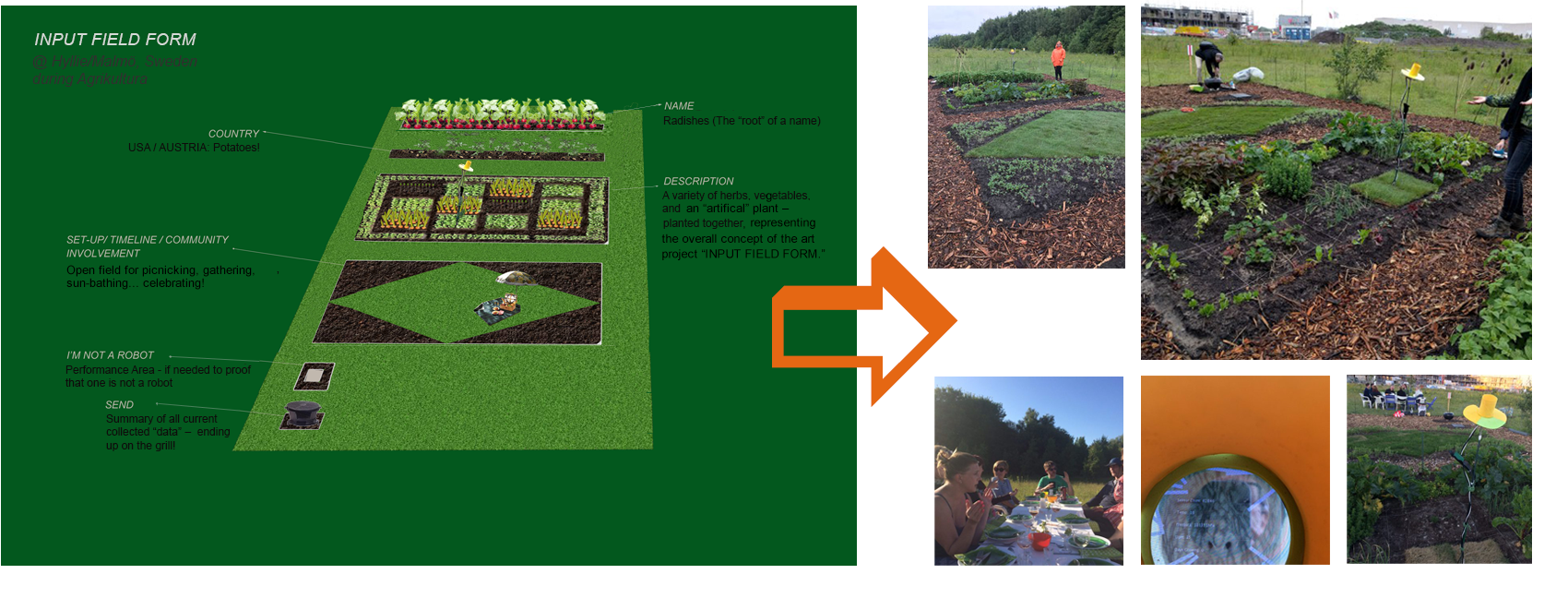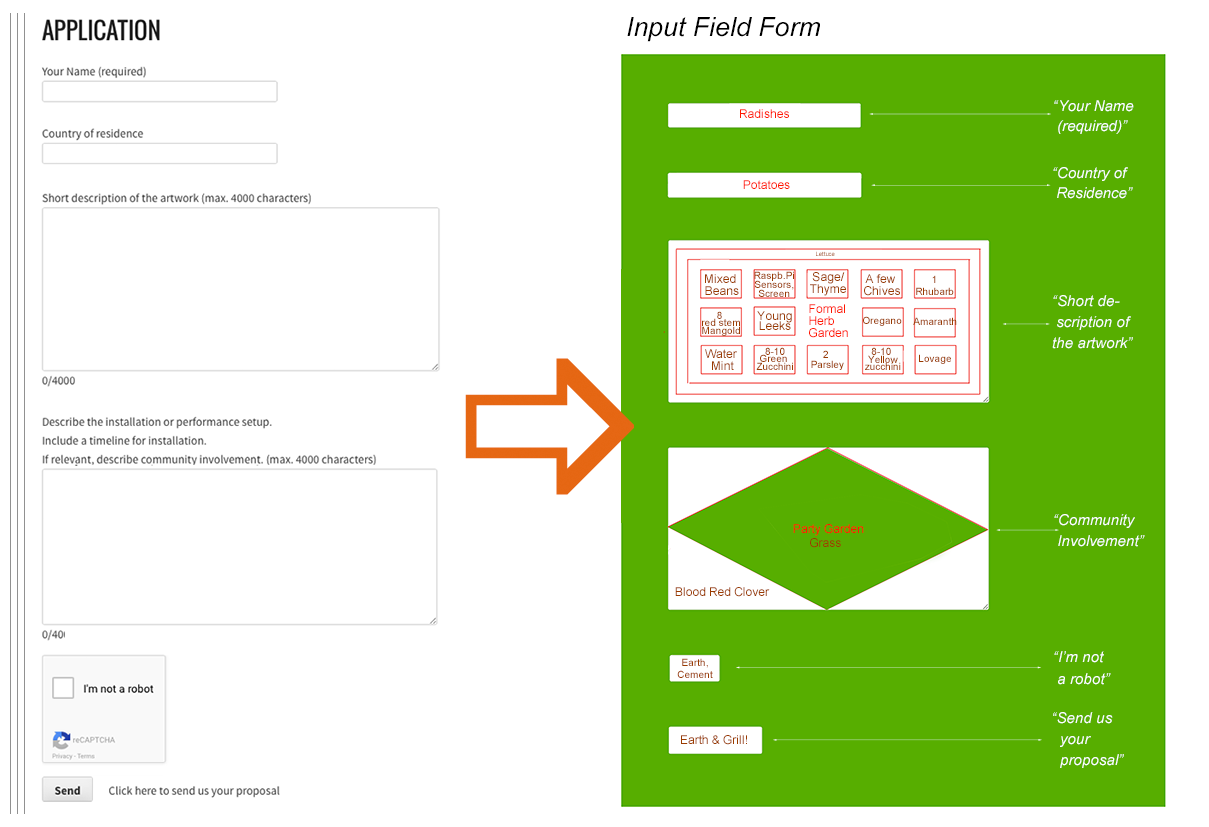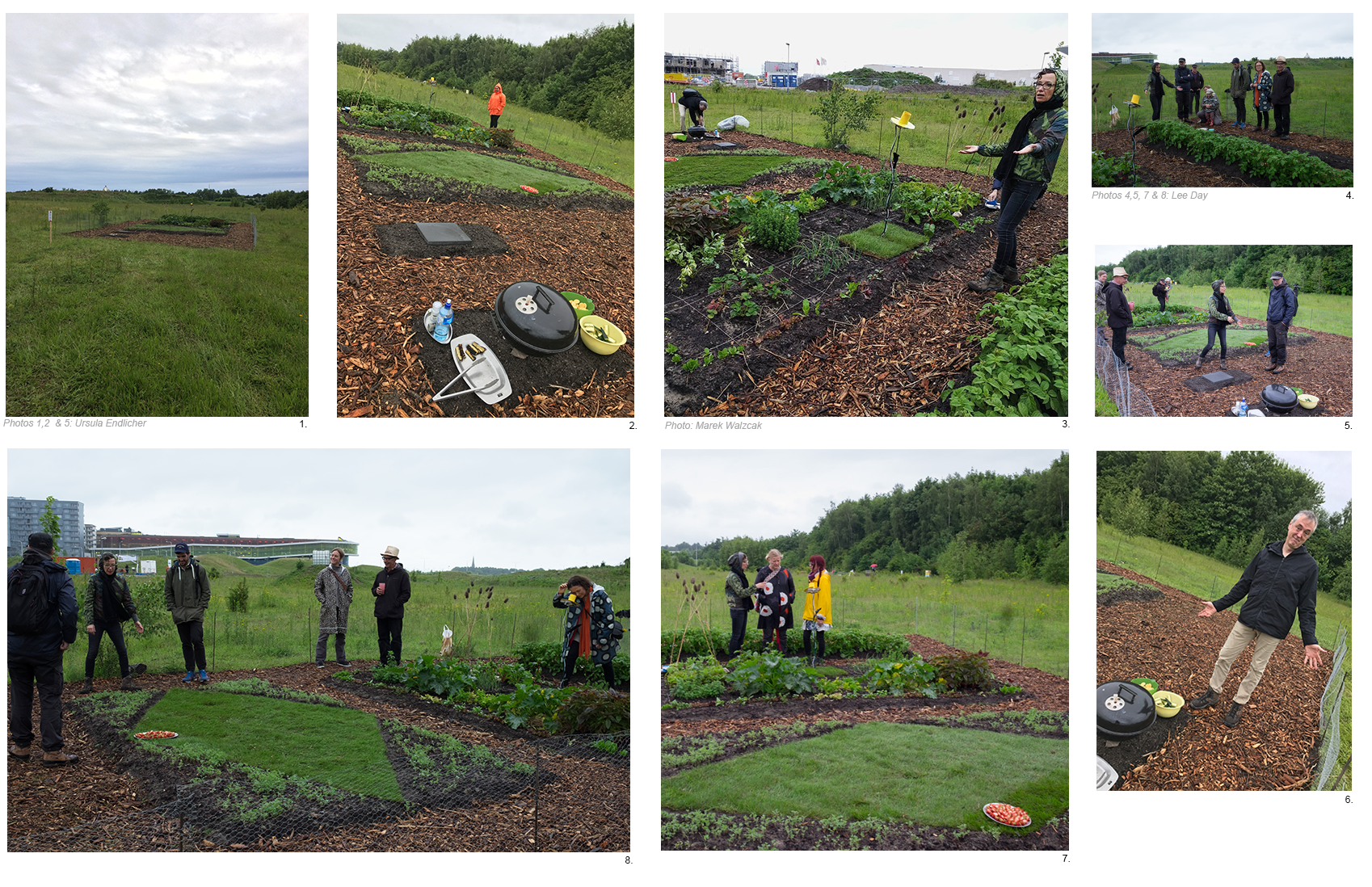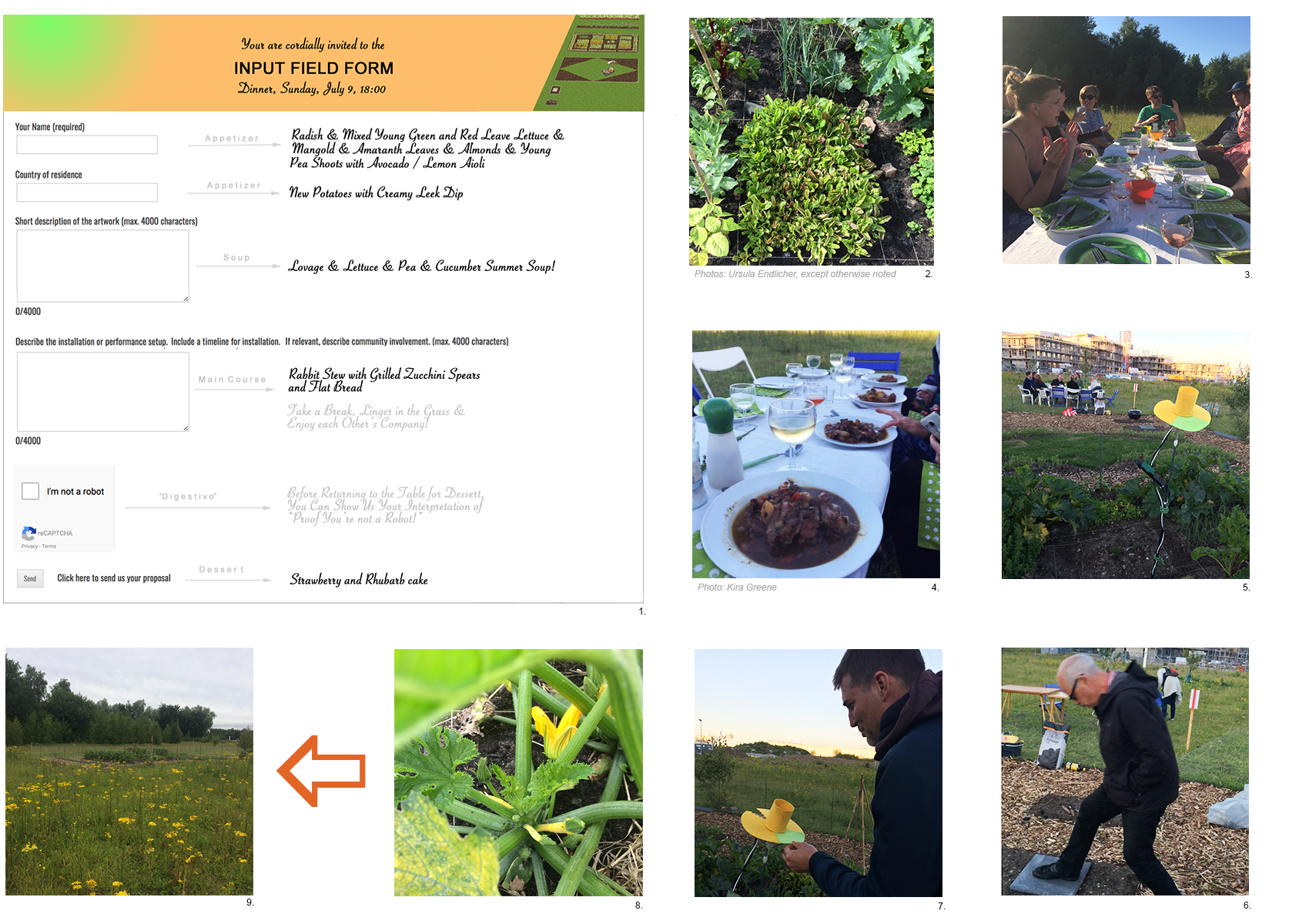URSULA ENDLICHER – INPUT FIELD FORM, 2017
<< home | ursenal

Input Field Form makes technological processes "natural". It turns the structures of the Internet –
the Web's Hypertext Mark-up Language – into the layout of a formal garden and turns Big Data and data collection into the process of natural
growth.
The online application form that artists had to fill out in order to participate in the exhibition Agrikultura becomes an agricultural field in the
landscape of Malmö/Sweden. Consisting of several <input> fields, each online field's functionality is translated into a horticultural
field with specific seeded plants such as radishes or potatoes, relating to the online question.
Instead of taking, Input Field Form gives back to the user: It invites visitors to stroll between the fields and come together for shared food
events harvested from the garden.
This project is today's answer to the tradition of medieval European medicinal-culinary gardens, which were dedicated to historic figures. Input Field Form
is dedicated to the Internet.
More documentation on Input Field Form at Agrikultura here.
MORE LINKS: Input Field Form Original Text/Proposal
Input Field Form Original Draft/Design
Original Application Form (serving as layout for Input Field Form)
INPUT FIELD FORM DESIGN / DEVELOPMENT, PLANTING / INSTALLATION, AND TOURS / PERFORMANCES / DINNERS:
TRANSLATION OF HTML INTO A GARDEN

December, 2016: Concept approved. Input Field Form will become an outdoor installation translating the Web form of http://agrikultura.triennal.se/application/ - Agrikultura's website and artists’ application submission form - into radishes, potatoes and other vegetables, as well as soil, and electronics. In Input Field Form the online form – used for collecting participant data – is "freed" from this function and transcends its usual format to become an agricultural field in the landscape of Hyllie/Malmö, Sweden, taking up an area of about Meter 12 x 6.5 Meters.
FIRST STEPS INTO THE LANDSCAPE

1. Earth pouring (City of Malmö) for Input Field Form, May 15, 2017 2. June 8: First round of digging and planting by Johanna (watering plants) and Marek 3. June 21: First Growth - Foreground: Potatoes (Field for "Country"), Mixed Herbs (Field for "Artwork"), Grass / Clover (Field for "Community")
EXTENDING THE FIELD

1. Size of initial Field (on arrival June 21) 2. & 3. Enlarging the whole field (Lee and Ursula), adding "frame" and more fields. 4. Adding wind protection around: Mixed Herbs ("Field for Artwork"), Potatoes (Field for "Country"), and Radishes (Field for "Name"). In the foreground new fields "Prove You are Not a Robot", and the ("Submit Button") where the grill will be ; also visible the field for "Community".
IN THE MEANTIME...

The Input Field Form garden also has a real electronic component. This "electronic plant" consists of an (in the earth) embedded Rasperry Pi (that runs on a large battery) with a Pimoroni Enviro pHAT sensor pack installed on the plant stem detecting light, pressure, and humidity level, which changes the behavior of a video creature that is displayed on a small screen inside of rubber flower petals. If it is too hot or there is too little light the creature is unhappy - but it is very happy under the conditions that are also beneficial for the natural plants in the field. Further functionalities for altering the video are “growth or ripening time” which are planned to be implemented once the Pi has acess to a WIFI network. The electornic plant then ripens over time: it changes it’s color from green to a ripe orange over the course of the exhibition. Additional sensor data such as ph Factor of the earth could be added to the sensor data input for changing the performance of the plant "creature"...
1. Development and Programming of Raspberry Pi and Sensors (Lee; plue earlier experiments by Yuxia and Ursula) 2. Building the flower (Ursula). 3. Inside of the "artificial plant" - The screen shows the plant's "face" (Ursula), which changes its mood by weather parameters. Current data shows a cooler temperature, less light, and lower air pressure. 4. The final artificial plant "growing" in the field...
OPENING DAY AND SAMPLING TOUR

During the opening of Agrikultura on July 1st the public was invited for a tour of the "Input Field Form" from 13:00-15:00. Visitors were introduced to the concept, and of how the layout of the piece is inspired by an HTML Input Field – by the online application form artists of the exhibit had to fill out in order to participate in the show. Transcending their usual format of collecting data, these Input Fields are "giving back" to the user. Furthermore, the functionality of each field is translated into a variety of planted vegetables, herbs, a sensor-based electronic plant, and more... Finger-food samples (= edible HTML) that were provided came either fresh from each specific field (if ripe) or were prepared live on site.
1. Input Field Form is getting ready for its visitors. 2. Food samples are placed around the fields. Front: The grill ("Submit Button") is starting up with Zucchini (green and yellow) spears; in the background: strawberries on display in the "community" field. 3. Front: Ursula gives a tour of the fields, in the back: Lee is grilling. 4. & 5. Visitors are getting a tour through the fields and can try out different snacks, try out radishes with chive dip, and learn about the option to perform in the "Prove you are not a Robot" field. 6. Lee in anticipation of grilling... 7. & 8. Ursula explains the fields' functions and encourages visitors for interactions...
THE INPUT FIELD FORM DINNER: A THANK YOU TO THE COMMUNITY

Input Field Form follows the medieval principle for the design of herb gardens in the coexistence of medicinal, culinary and ornamental plants. As much as in historic gardens different fields were dedicated to historic figures, the Input Field Form "garden" is dedicated to the Internet. It is structured by the Web form's functionality, and each agricultural "sub-field" therefore is dedicated to a specific functionality in the online Input Field. So, for instance, the online form field that asks about community involvement will be hosting an event for all participants celebrating, harvesting and eating the food that has grown inside the installation.
Also the menu for the dinner is based on the logic and layout of the online fields: each prepared dish corresponds to each field's functionality (= edible HTML).
1. The Input Field Form Menu 2. Happy mangold (center) as well as Lovage, Beans, ... 3. Starting the meal - in anticipation of the first appetizer: mixed Leave Salad fresh from the field! 4. About to start the Slow-Cooked Rabbit Stew! 5. A view form the "Artwork" field to the dinner gathering 6. Marek trying to prove he is not a Robot! 7. Erik inspecting the "artificial plant" 8. Zucchini blossoming and starting to grow fruit... 9. Good-Bye, Input Field Form! Ursula is leaving Malmo July 8... The field produced a lot of veggies and herbs for the rest of the exhibition - and kept inviting participants and guests to harvest!
And, one a final note, Input Field Form can turn any online form into a horticultural garden... and feast!